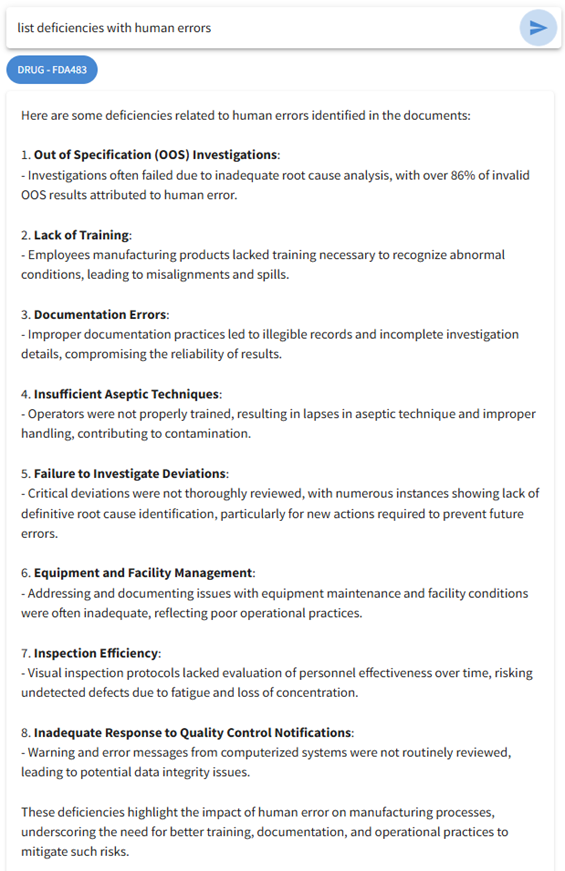Smoke Studies in Clean Rooms/Areas - Tips to address Warning Letter and FDA-483 Trends
- Binh Nguyen
- Jun 10
- 3 min read
Updated: Jun 12
Smoke studies (airflow/air pattern visualization studies) continue to surface on FDA-483 observations and trend to be among the top 10 deficiencies going back since 2013 cited under 21 CFR 211.133(b) - Control of microbiological contamination - which states that "Appropriate written procedures, designed to prevent microbiological contamination of drug products purporting to be sterile, shall be established and followed. Such procedures shall include validation of all aseptic and sterilization processes." --> although this is a production citation, it also impacts other systems including laboratory (microbiology), materials, facilities and equipment (design/engineering), and of course quality - that is 5 out of 6 systems. Here are a couple of examples from a Warning Letter and an FDA-483.

Some pointers of smoke studies to be addressed in your protocol and report are:
At rest (static) conditions
In operation or operational (dynamic) conditions
Clean room/area design (HVAC, HEPA certification, air returns)
Personnel Flow (gowning, number of personnel)
Materials Flow
Equipment Set-up (stationary vs. moving)
Interventions to align with actual practices
Conducted in critical areas (typically ISO 5 and ISO 6) where open vials, bulk solutions, containers and closures are exposed (assess ISO 7 zone if there is airflow impact into ISO 5/6 zones)
Ensure unidirectional airflow (avoid turbulent airflow in critical operations even in isolators especially during filling operation)
Ensure enough smoke to be sufficiently visible and cover different angles of critical operations
Ensure cleaning after smoke studies are conducted prior to resuming manufacturing
Ensure that wand is not pointing in the same direction as the airflow
Should be done initially and repeated if there are significant changes
Document findings and conclusions as well as corrective actions
Some trends of smoke studies deficiencies from Warning Letters and FDA-483s are
Lack of Simulation of Interventions: Smoke studies failed to simulate critical aseptic interventions and dynamic activities that occur during manufacturing, compromising the assessment of airflow patterns.
Inadequate Visualization: Smoke studies did not provide sufficient visualization of airflow behaviors, making it difficult to confirm unidirectional airflow necessary for sterile protection.
Dynamic Conditions Not Accounted For: Studies were not conducted under dynamic conditions, which are essential to evaluate real-world scenarios affecting airflow during aseptic processing.
Insufficient Smoke Generation: The generation of smoke used to assess airflow was inadequate, limiting the efficacy of the studies in demonstrating controlled airflow.
Failure to Include Operator Movement: Smoke studies neglected to assess how personnel movements during intervention could disrupt airflow patterns, posing contamination risks.
Turbulence in Critical Areas: Observations noted instances of turbulent airflow in critical zones where sterile products were handled, which can endanger sterility.
Absence of Controls: There were no physical barriers or other controls in place to protect against potential disruptions to the airflow patterns during manual interventions.
Evaluation of Non-Routine Activities Lacking: Smoke studies did not adequately evaluate non-routine activities that could affect airflow, which are vital for ensuring the integrity of sterile environments.
Absence of Aseptic Techniques: Observations indicate that the smoke studies did not accurately depict aseptic conditions, often neglecting critical manipulations during the processes, like setup for filling operations.
Improper Smoke Generator Positioning: In some cases, smoke was generated in alignment with the airflow rather than perpendicular, which can diminish the effectiveness of the visual studies.
Lack of Comprehensive Documentation: Many reports lacked adequate documentation or review processes for the smoke studies conducted, with no evidence that results were critically assessed before approval.
Failure to Include All Critical Areas: Smoke studies often did not evaluate all critical areas and interventions impacting airflow, such as those occurring at the doors between different pressure environments.
Equipment and Environment Interaction Neglected: Studies did not account for airflow around obstacles such as equipment and supplies, which obstruct airflow patterns and could lead to contamination.
Failure to Audit Past Studies: Facilities did not conduct adequate retrospective reviews of their smoke studies to identify shortcomings and ensure compliance with updated procedures.
Inadequate Response to Previous Findings: Many reports detail that past recommendations and corrective actions were not fully implemented, leading to repeated deficiencies in airflow evaluations and aseptic practices.



Comments